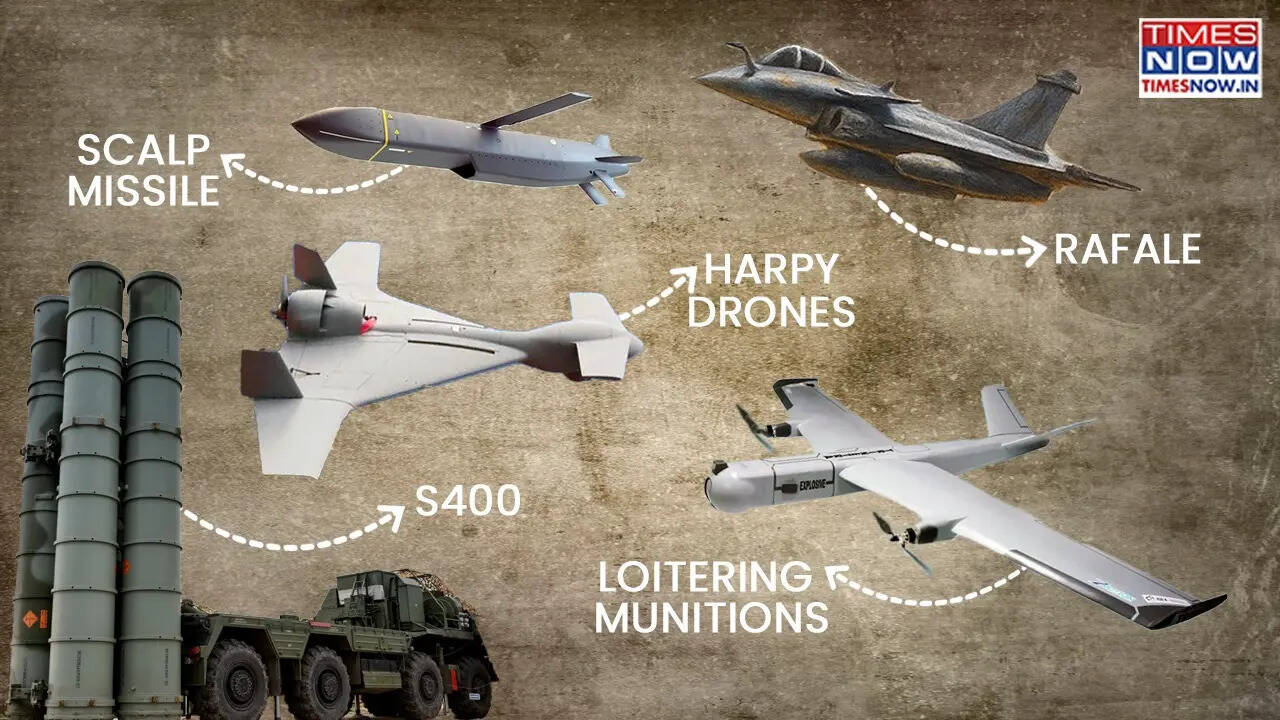Trending:
Rafales Strike, S-400s Shield: What Was India's Dual-Front Response To Pakistan's Offensive – Explained
India executed precision strikes on nine terror-linked sites in Pakistan and Pakistan-occupied Kashmir on May 7, prompting a retaliatory drone and missile attack from Pakistan the following night. India’s air defence systems effectively neutralised these threats. The operation involved coordinated efforts from the Army, Navy and Air Force, utilising advanced weaponry like Rafale jets, SCALP missiles, and loitering munitions.

India’s precision arsenal, from S-400s to loitering munitions, ensured decisive success in Operation Sindoor.
After carrying out precision strikes on nine terror-linked locations across Pakistan and Pakistan-occupied Kashmir in the early hours of May 7, India faced a retaliatory offensive from Pakistan the following night. In an attempt to target multiple military sites across northern and western India, Pakistan launched drones and missiles - but India’s robust air defence systems swiftly intercepted and neutralised the threat. By striking key air defence radars and installations in Pakistan, India demonstrated the strength and precision of its defence network. Just how advanced is India’s air defence system, and what makes it so effective against such threats?
The operation was executed with extreme precision and involved coordinated efforts from the Indian Army, Navy, and Air Force. In addition to Rafale fighter jets, the strike force employed advanced weapon systems including loitering munitions, SCALP cruise missiles, and HAMMER bombs. These successfully neutralised nine terror camps across Pakistan and PoJK.
With the induction of 36 Rafale fighter aircraft, armed with long-range SCALP missiles, India now possesses the capability to strike deep inside enemy territory - without even crossing the border.
Here's an in-depth look:
India’s airspace is under constant surveillance through an integrated network of radars, drones, and aircraft. Any potential threat approaching the border is immediately detected and tracked by this system. From large, stationary radars to smaller mobile units, all data is relayed in real-time to a central Command and Control Centre, as well as to regional units. This network serves as the nation’s ever-vigilant eyes, operating round the clock. At the first sign of danger-whether it's an enemy fighter jet, drone or missile- the entire air defence apparatus is swiftly activated to neutralise the threat.
How the Air Defence System Works
India fired S-400 Sudarshan Chakra air defence missile systems to down drones and missiles used by the Pakistan military to hit military targets in Northern and Western India. The targets were successfully neutralised in the operation. "On the night of 07-08 May 2025, Pakistan attempted to engage a number of military targets in Northern and Western India including Awantipura, Srinagar, Jammu, Pathankot, Amritsar, Kapurthala, Jalandhar, Ludhiana, Adampur, Bhatinda, Chandigarh, Nal, Phalodi, Uttarlai, and Bhuj, using drones and missiles," the Minister of Defence said in a statement.Following the engagement, the projectiles were neutralised by the Integrated Counter UAS Grid and Air Defence systems
The S-400 is among the world’s most advanced long-range air defence missile systems. Integrated with the IAF's command and control network, each S-400 squadron consists of two batteries, each equipped with six launchers, advanced radar, and a control center, supporting up to 128 missiles per battery.
The air defence missile systems was procured by India from Russia. The Rs 35,000 crore deal for five S-400 squadrons was signed in 2018. So far, Delhi has procured five squadrons, with three already operational and two more expected by 2026.
How the S-400 Works:
1. Transport Erector Launcher (TEL): The guidance radar directs the missile towards the target.
2. Surveillance Radar: The surveillance radar tracks objects and provides instructions to the command vehicle.
3. Command and Control Vehicle: The command vehicle identifies the target location and issues instructions for missile launch.
4. Guidance Radar: The launch vehicle, located near the target, fires the missile. The S-400 has a range of 380 km and is capable of intercepting threats ranging from drones to ballistic missiles.
5. Long-Range Interceptor: If the threat is detected from a long distance, a long-range weapon system is used to neutralize it before it reaches the target area.
Medium Range Interceptor Works (MRSAM)
If the aerial threat advances, India also has the Medium Range Surface-to-Air Missile (MRSAM) for interception at medium range.. The Barak missile can destroy threats coming from the enemy within a range of 70 kilometers
Close Range Interception (IGLA-S)
If the threat approaches too close, the Igla-S Man-Portable Air Defense System (MANPADS) is deployed to neutralise it. It is also capable of destroying fighter jets, drones, and helicopters. It has range of 5-6 km. This is a shoulder-launched missile, weighing 18 kilograms. It mainly deployed on the army's forward post.
Short Range Interceptor (Aakash)
The "Aakash" is an Indian-developed, short-range surface-to-air missile system (SAM) designed to protect vulnerable areas from air attacks. It's a crucial part of India's air defense capabilities, capable of engaging multiple targets simultaneously. The Aakash system is mobile and includes electronic counter-countermeasures (ECCM) for increased effectiveness.
It has built-in Electronic Counter-Counter Measures (ECCM) features. The entire weapon system has been configured on mobile platforms. It has range of 25-30 KM. Its unit can destroy 4 aerial targets. It has accurate targeting, and can be deployed quickly anywhere. It is capable of destroying enemy missiles, fighter jets, and drones. Additionally, there is SPYDER, a surface-to-air missile system capable of destroying low-altitude targets
India's SEAD
India on Thursday executed a high-impact SEAD (Suppression of Enemy Air Defences) operation, targeting and destroying key Pakistani air defence systems. Formally known as Suppression of Enemy Air Defences (SEAD), this tactic involves disrupting or destroying enemy air defence systems — such as radars and missile launchers — that pose a threat to Indian aircraft. When the mission focuses specifically on physically eliminating these threats, it is also referred to as DEAD, or Destruction of Enemy Air Defences. SEAD, or Suppression of Enemy Air Defenses, is a crucial military tactic used to disable or destroy enemy air defense systems, such as radar stations and surface-to-air missile (SAM) launchers. The main goal is to create a safer airspace for friendly aircraft, allowing them to operate freely in hostile environments. In modern warfare, where adversaries often deploy sophisticated air defence networks, SEAD missions play a vital role in gaining and maintaining air superiority.
Harop Drones
India reportedly used Israel-made Harop drones while retaliating against Pakistan's attacks on the night of May 7-8. The drones are developed by Israel Aerospace Industries (IAI) and are a next-generation loitering munition system. Harop serves dual purpose - it not only acts as a surveillance drone but also as a lethal missile. It is a loitering munition system and can loiter over a target and can attack upon detection. The Harop drones boasts a impressive endurance of up to 9 hours and an operational range of upto 1,000 km. Harop drones operate autonomously to search, identify, and track targets. Also, it allows its operator to make real-time decisions. Through this, an operator can change drone's mode and even abort an ongoing mission.
Loitering Munitions
Loitering Munitions (LMS), also called ‘Kamikaze Drones,’ are atype of precision weapon that hovers over a target and waits for it to appear. Once identified, they dive in and destroy the target with high accuracy. Loitering Munitions combine the surveillance capability of drones with the firepower of missiles and can either operate autonomously or be controlled by the operators in real time. This weapon technology enables the forces to avoid collateral damage and target mobile or time-sensitive threats, operate without risking soldiers' lives.What is SCALP/STORM SHADOW Cruise Missile?
The Scalp, also known as Storm Shadow, is an air-launched cruise missile known for its stealth features specifically designed for long-range strikes, and it is capable of being operated at night and in all weather. The Scalp missile's accuracy is backed by its advanced navigation system, which uses INS, GPS and terrain referencing. The missile, having a range of 300 km, is manufactured by MBDA, a European consortium. It is seen as an ideal weapon for breaching hardened bunkers and ammunition stores. After launch, the weapon descends to terrain hugging altitude to avoid detection. On approaching the target, its onboard infrared seeker matches the target image with the stored picture to ensure a precision strike and minimal collateral damage.
HAMMER Air-To-Ground Bomb
The other weapon said to have been used in Operation Sindoor, HAMMER (Highly Agile Modular Munition Extended Range), is an all-weather air-to-ground precision-guided munition. A Hammer bomb with a range of up to 70 km can be fitted to standard bombs. The bomb, made by French company, is insensitive to jamming and can be launched from low altitude over rough terrain. The fact that it is difficult to intercept and can penetrate fortified structures is what makes it so effective.
Get Latest News Live on Times Now along with Breaking News and Top Headlines from India and around the world.
End of Article
Subscribe to our daily Newsletter!






Explosion At Jammu Air Force Base? Centre Fact-Checks Viral Claim

Cash Row: CJI Recommends Impeachment of Justice Yashwant Varma, Say Sources

Object Suspected to be Pakistan's Missile Debris Found in Jaisalmer's Kishanghat | Watch Video

Centre Authorises Army Chief To Call Back Territorial Army Amid Tensions With Pakistan

Complete Blackout in Ambala Today for 10 Hours-Check Timings













